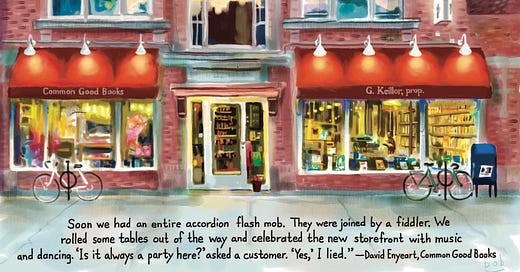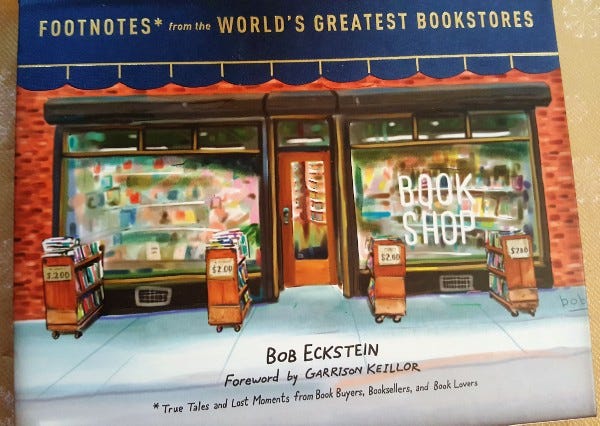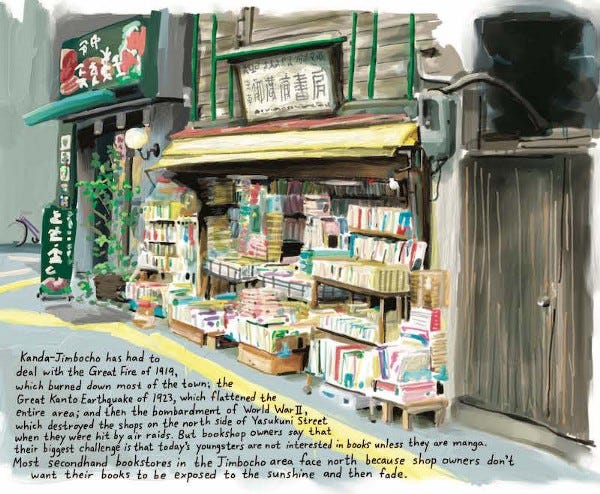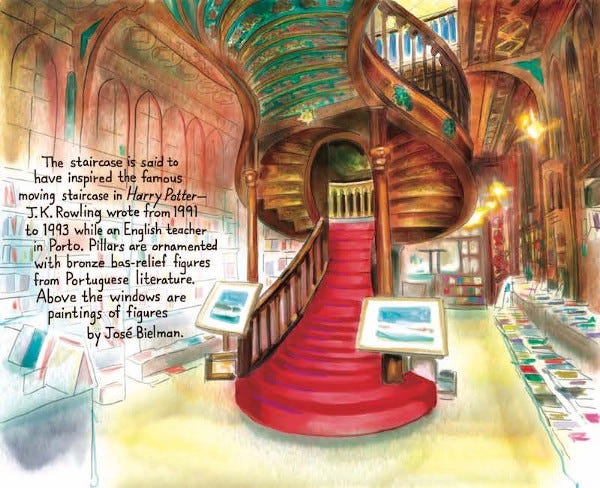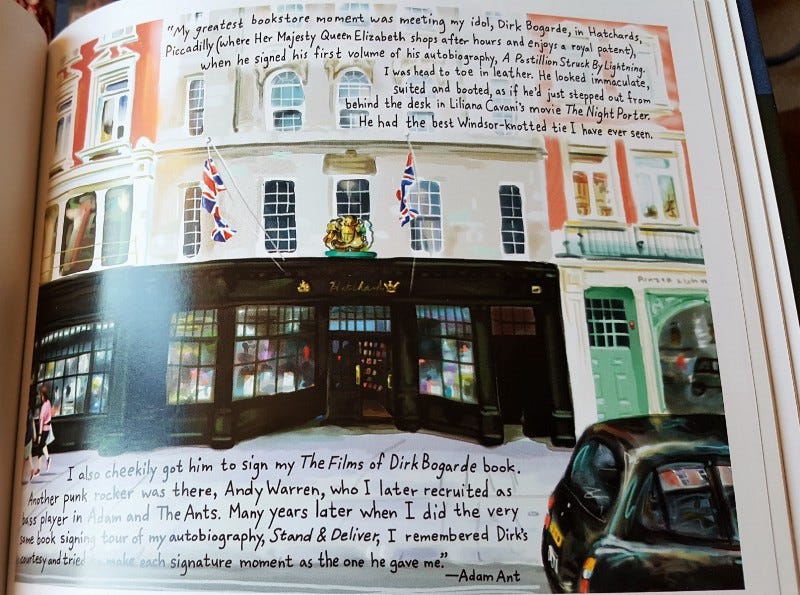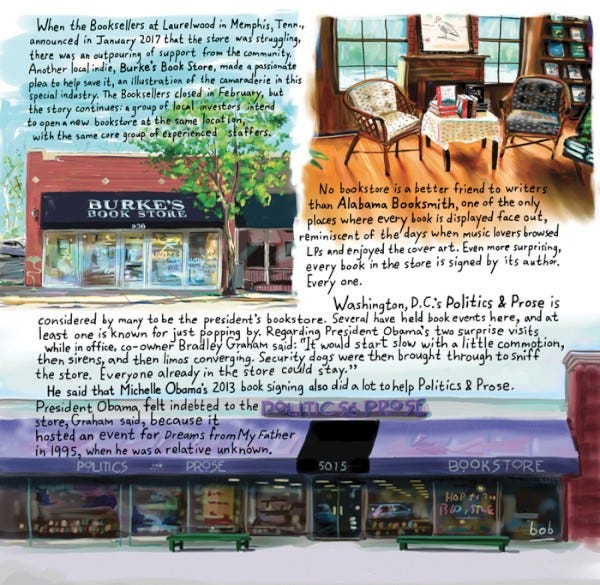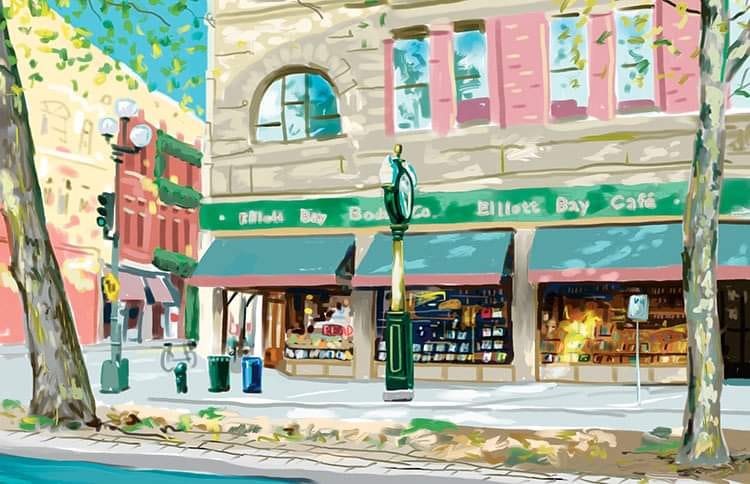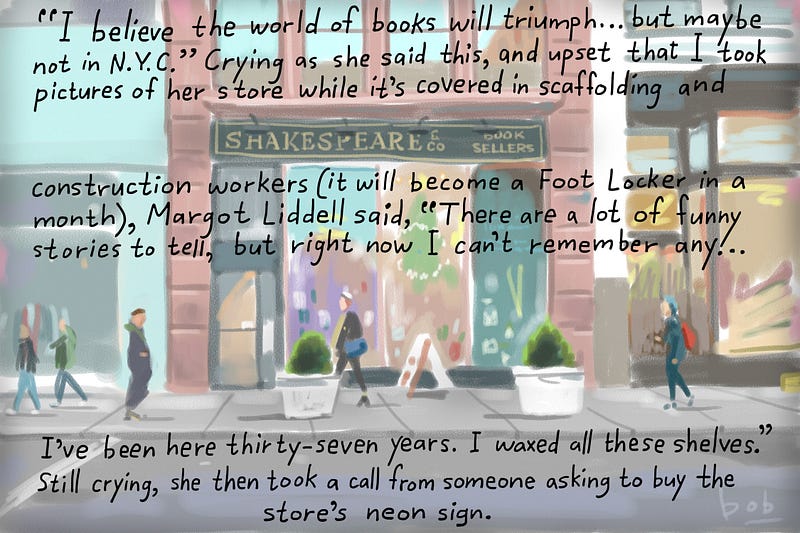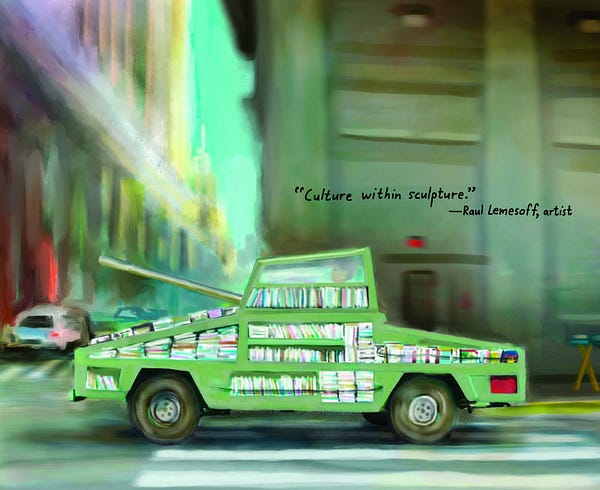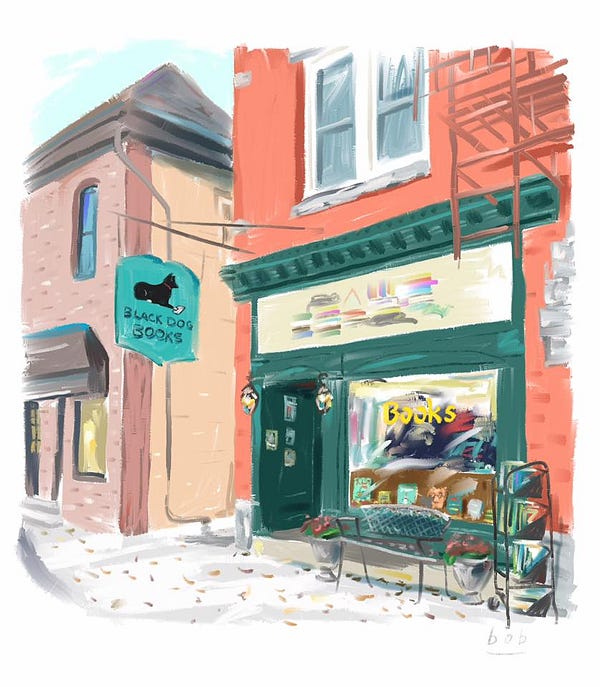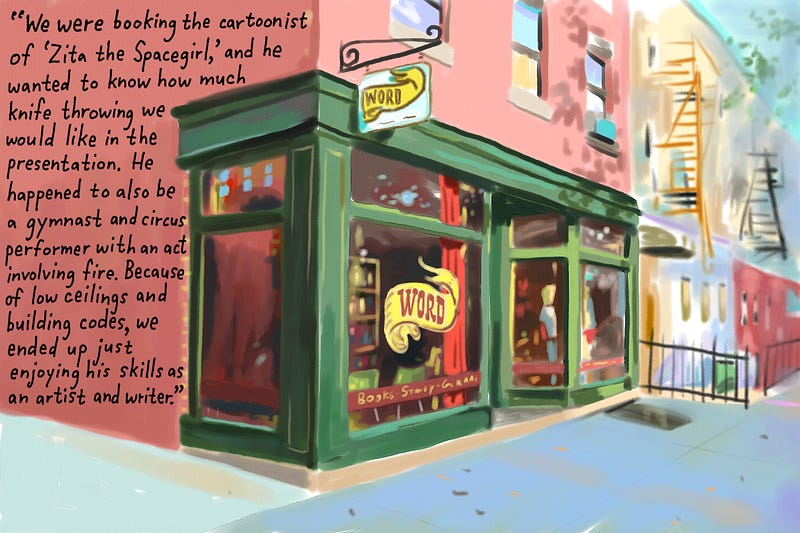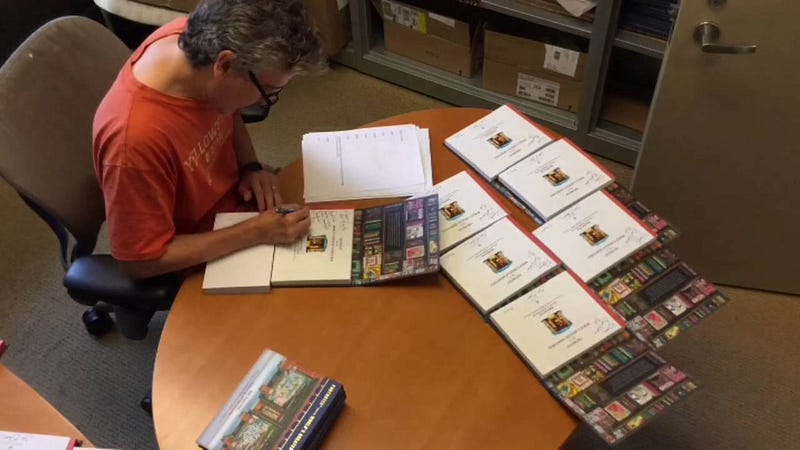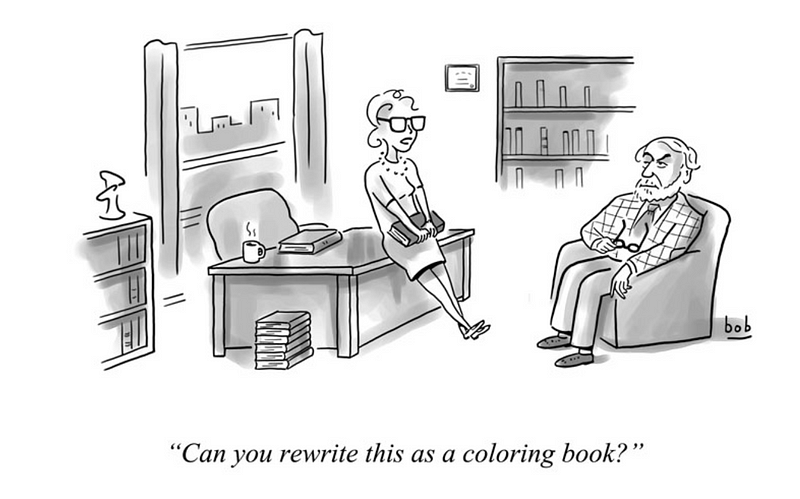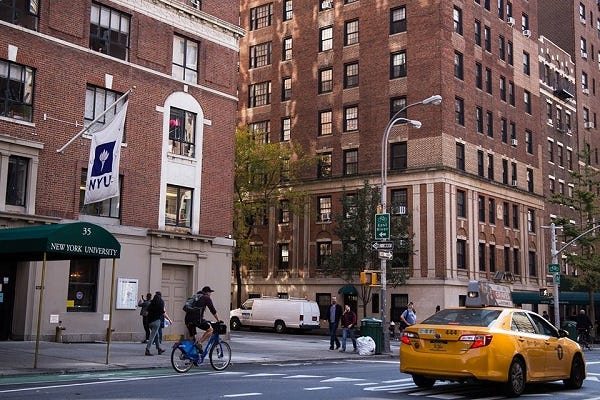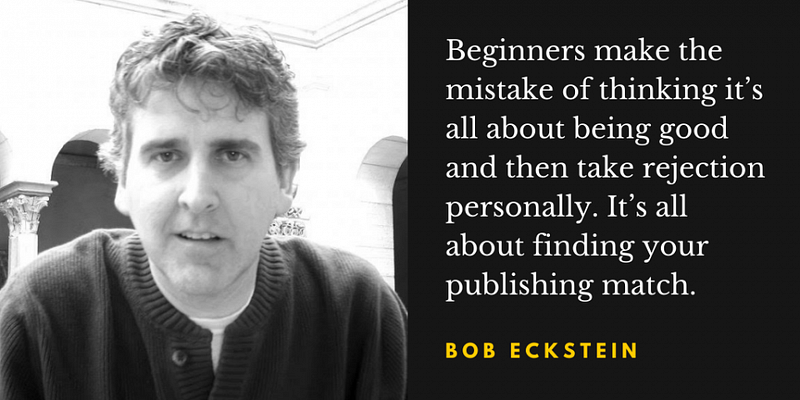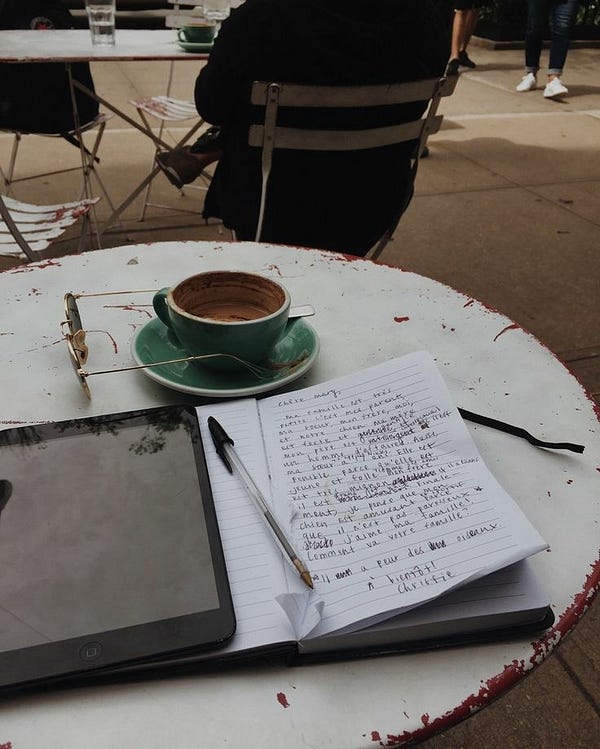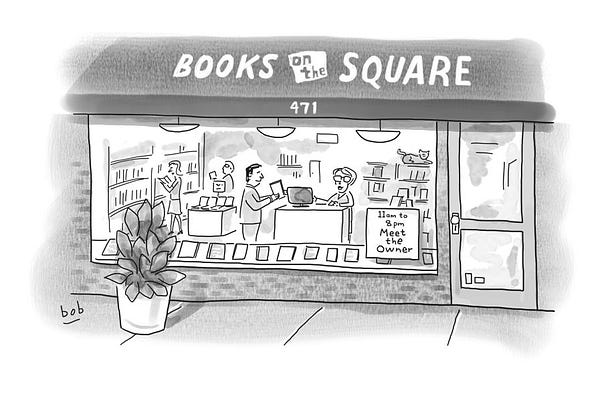Interview with Bob Eckstein (New York Times Best Selling Author & New Yorker Cartoonist)
Bob Eckstein is an award-winning writer, New Yorker Cartoonist and author of The New York Times best-selling Footnotes From the World’s…
Bob Eckstein is an award-winning writer, The New Yorker Cartoonist and author of The New York Times best-selling Footnotes From the World’s Greatest Bookstores. He has been consistently speaking publicly against online shopping from E-Commerce portals & websites to raise awareness for independent bookstores and local businesses.
He teaches Journalism (Writing and Illustration) at Arthur L. Carter Journalism Institute , New York University (NYU) as an Adjunct Faculty.
He also writes for Writer’s Digest as a Contributing Writer.
Articles by Bob Eckstein
Articles by Bob Ecksteinwww.writersdigest.com
The Tragical Mystery Book Tour (Part 4)
At the risk of too much of a good thing being a bad thing, here is one last installment in author and New Yorker…www.writersdigest.com
The Endangered Bookstores of New York
Recently, I was browsing for books at Powerhouse Arena, in Dumbo, and noticed a sign asking people not to snap photos…www.newyorker.com
Bob Eckstein
Read more from Bob Eckstein on The New Yorkerwww.newyorker.com
As world’s renowned snowman expert and author of the popular book, The Illustrated History of the Snowman (Globe Pequot, 2018) and The History of the Snowman (Simon & Schuster, 2007)and most recently, The Ultimate Cartoon Book of Book Cartoons and Everyone’s A Critic. He has also spoken at key gatherings and has appeared in over hundred media and radio interviews worldwide.
His Award-winning illustrations have appeared in hundreds of books and magazines, He has drawn Leonardo DiCaprio and Lady Gaga live at the Golden Globes, illustrated the backstory of eccentric NFL plays.
His artwork has been exhibited in The Cartoon Art Museum of San Francisco, the Smithsonian Institute, The Cartoon Museum of London and The Sordoni Art Gallery at Wilkes University.
He had also taught Illustration and Fine Arts at School of Visual Arts and Pratt Institute.
ABOUT THE BOOK
Any individual who like to spend time in a bookstores, then having this book on their rack is the next best thing. The book contains exquisite watercolor painted photographs of the storefronts, a short fascinating history of the store, and an anecdote about some extract that happened there.
The book features an incredible range of adorable bookstores from across the world and stories from writers, thinkers and artists including David Bowie, Tom Wolfe, Jonathan Lethem, Roz Chast, Bob Odenkirk, Philip Glass, Jonathan Ames, Terry Gross, Mark Maron, Neil Gaiman, Ann Patchett, Chris Ware, Molly Crabapple, Amitav Ghosh, Alice Munro, Dave Eggers, and many more.
“Bob Has Painted 75 Legendary Bookstores”
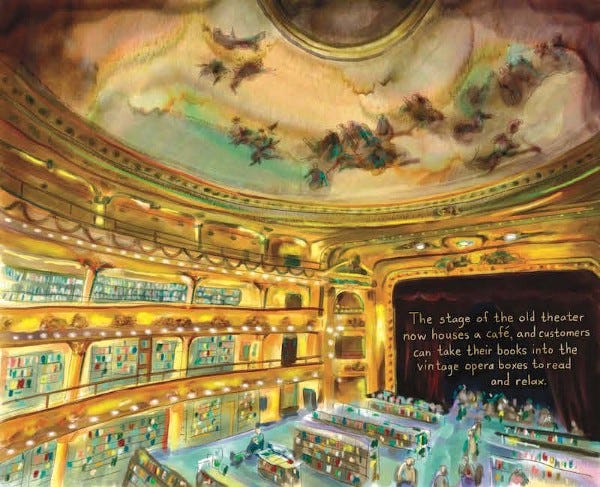
The heart of the book is Bob Eckstein’s paintings, which are flat-out lovely, especially the ones that depicts glowing storefronts in the evening. Each artwork and illustration managed to capture the intangible spirit and personality of the store.
Purpose of Illustrating 75 Bookstores from Around The World
Bob Eckstein depicted Resilience and Intangible enchantments through his Paint Brush.
In the wake of talking with book shop owners and workers from around the globe for illustrating 75 lovely book shops. He was able to gather intriguing stories from each store likewise which also allowed him to meet innumerable incredible artists and thinkers.
Bob has done serious research while giving this book an actual existence. He listened to the narratives of resilient privately- run companies/family businesses. He comprehended their high points and low points, their goals and accomplishments. Every so often required the persistence of a holy person as he went through hours hearing about the importance of the store cat. He gathered a decent measure of clever stories from entertainers like Robin Williams, Dave Barry and Monty Python’s Michael Palin.
The stories from bookstore owners were normally the most moving. Frequently, he was so fascinated by the book shop he had visited that he couldn’t wait to reach home so that he could begin the process of illustrating as soon as possible.
Every indie- bookshop is unique and have their own personalities, according to Bob Eckstein, some of them have resident cats, attract eccentric regulars and have inspired marriage proposals among the shelves.
The project stemmed from an assignment by an editor at the The New Yorker, who asked Bob Eckstein to illustrate “endangered bookstores” around the city.
He had begun with a list of 150 bookstores, from which he gathered more than 300 tales. He figured that his book could raise awareness for indie book stores.
The book stores that registered for bankruptcy during the creation of the book accused Amazon and the online market’s cost slicing. Clients made a propensity for utilizing physical stores to browse, shop and scan, just to buy online later. This has been a long-standing issue. How to make a book shop more than a library ?
HOW TO CULTIVATE THE ATMOSPHERE , THAT A BOOKSTORE COULD OPEN A WHOLE NEW WORLD FOR AN INDIVIDUAL?
There are a few factors important to get that going . It starts with individuals giving more regard and respect to books and writers.
Let’s have a conversation with Bob and understand his perspective.
Q1) How did you decide to write this book: Footnotes from the World’s Greatest Bookstores? Page by page, you had effortlessly captured lifelong love affair with books, bookstores, and book-sellers that is at once heartfelt and bittersweet. What was the writing process from the beginning to an end? What inspired you? How did you decide which bookstores to include? How many years of research or work were put into this project?
Bob : I spent a couple of years completing the project thanks to the help of friends who love books and who are in the business. The project began as a regular assignment, in the New Yorker magazine, and it mushroomed into something I became emotionally invested in and quite involved beyond the completion of the book, speaking out publicly and trying to raise awareness for independent bookstores. The bookstores were narrowed down to the top 300. Then I colllected stories and cut the list down to 150. I then choose the best 75 bookstores I painted. I based my selections on historical importance of the store, their possible role in the community, in some cases, their beauty and finally, which had the best stories.
Q2) Majority of the businesses exist just to accomplish triple bottom line: they’re structured purely to be an environment in which a transaction happens between the buyer and the seller.
Bookstores — particularly independent ones — are unique. Although revenues are significant (maintaining profit margin is vital for their survival), this is basically result of an altogether nobler point: to be a peaceful and safe haven where readers can communicate ideas with an evangelical zeal through words and pictures. Do you agree with this? While the internet, kindles and branded chains of bookstores battered the fortunes of little bookshops across the world, it’s reasonable in many places that bricks-and-mortar stores are enduring — and, in some cases, flourishing. What’s behind this renaissance?
Bob: Bookstores are the intellectual hub of a town’s Main Street, so yes, I agree with your assessment. But nowadays every physical store is struggling and despite the occasional good news of stores doing well, readers and writers have to support them if they have a chance of surviving.
“I can’t speak for all individual, but I know why I keep going back to bookstores . I enjoy the way a good bookstore makes me feel — welcomed, excited and connected. I like the intangible serendipity these bookshops offer: the way you could come across a new book quite simply by skimming the rack and picking at random, or by selecting something that has, with its exquisite cover. It’s a way of discovery that has no equivalent in the online platform.”
Q3) Do you think that independent bookshops play more of a social role than being that of a retailer?
Bob : Of course. What other store has on its shelves the hopes and dreams of thousands of artists and writers? Bookstores, pun intended, literally, changes lives, especially that of our children.
Q4) Please do tell our readers here about your publishing expedition from The Illustrated History of the Snowman to Footnotes from the World’s Greatest Bookstores to the series of cartoon books?
Bob : I try to produce books I think people will love and remember, no matter the subject with on eye out for it being a physical experience that is not easily replaced by an ebook or audio tape. So I produce the most lush beautiful books I can, and keep them as affordable as possible. I’m proud to say my collection of books are a visual delight!
Q5) You seem to have best of both worlds. Skillsets of both Writing and Illustration. Did you became writer first or an illustrator first? What is your history with writing, literature and illustration? Were you surrounded by the artistic environment during your childhood? How did you nurtured yourself to these fields?
Bob : I was an artist as a kid and wrote as I got older. I want to art school but did not really study writing. I did not grow up in an artistic environment. Not even cartoons were really a part of my childhood. I got excited about them and the New Yorker much later in life by accident and didn’t start doing cartoons until 2007 when I was in my mid forties.
Q6) What message you wanted to communicate to your readers through this book?
Bob : How special bookstores can be and how they have changed so many lives. In my book I found many people, both anonymous and well-known, sharing how a bookstore changed their life. In some cases it’s remarkable and heart wrenching.
Illustrating the 'World's Greatest Bookstores'
8/30/2016 11:00AM Illustrator and New Yorker cartoonist Bob Eckstein discusses his book, "Footnotes* From the World's…www.wsj.com
Q7) What’s something important you learned in the process of publishing your books?
Bob : Foremeost, that it’s a very difficult business. People assume I’m rich because my books are popular. Writers get just a small percentage. I haven’t been able to make a living for books yet. As far as the craft of the books, the writing and artwork, I’m always learning and improving.
Q8) What other authors are you friends with, and how did they help you become a better writer?
Bob : I can’t say my writing is based on anyone else’s style or that a single book influenced my tittles. I just write what the material dictates or what the characters in my books would say. Now as far as cartooning goes, everything I’ve done I’ve been influenced by my cartooning friends. I can’t single out one person for fear of leaving out anyone but they know who they are.
Q9) What is the best thing about being a writer?
Bob : The hours.
Q10 ) How writers have it harder than Hemingway and what can be done about it ?
Bob : Your book comes out. The champagne cork has popped. You contact your alumni newsletter. You have a spanking new designated Facebook page for your new baby. You get blurbs up the kazoo. So it can be very disheartening the first time you visit your Amazon page and see numbers you didn’t know went that high and the only review is from your mom. You cancel that subscription to “Bestselling Author Digest,” cancel the order for the indoor lap-pool and wondered what happened.
It’s important to remember that today writers have it much harder than those of yesteryear. I’ve seen this firsthand. Not because of my new book but meeting with bookstore owners and bestsellers the past two months (including at the Miami Book Fair and the ABA Winter Institute). I also previewed an advance copy of The American Writer by Larry Samuel, which in part explains the uphill problem all writers now face.
Here are five examples how we have it harder than Hemingway
More Competition: There were not a trillion new releases every year back in Hemingway’s day. The numbers are certainly stacked against us. But remember, most of them are cookbooks or books with cats. The answer is to maintain realistic expectations. Most bestseller lists are now made up of miscellaneous titles. Pay less attention to online rankings….unless you write a cookbook for cats.
Multi-tasking : Hemingway didn’t have to do social media, shoot video trailers, and I guarantee you, he never glue-gunned snowman mobiles in window displays like I had to when my first book came out (The History of the Snowman). For each book I make posters, bookmarks, and write hand-written letters to indie bookstores. And can you imagine Hemingway even having a Facebook page? Today’s writers have to wear many hats but there are online resources now to learn all of this including webinars and blogs like this one. Nothing like this existed back in the day where it seems the writer’s only source of comfort was the bottle.
Appearances : This sounds like a trivial thing but our appearance has never mattered so much, an annoyance the likes of Ernest Hemingway didn’t have to deal with. Now, more than ever, readers what to know as much about their favorite writer as possible. For many writers, this is way more than we bargained for when pursuing this craft. I suppose, in this case, we have to count our blessings that the public cares enough to want to know what we look like and as a result, this public connection can be monetized in the form of public speaking engagements and unprecedented branding for our titles. Publishing is one field that has been immune to ageism (for the most part), another blessing. Besides, another advantage we DO have today is Papa didn’t have Photoshop.
Advances : In relation to the value of the dollar then, Hemingway’s generation of writers enjoyed, on average, higher advances. Advances are shrinking. It’s a matter of the pie being sliced up too many ways now, a relatively recent occurrence. It’s not easy. We’re writing in a time when there is no middle class for writers–advances are all or nothing and often you’re at the wrong end of the stick if you don’t host your own TV show. But there are other avenues to try to make up for the sting. Ebooks…um…teaching…did I mention ebooks? Best we move on…
Book Events : Now I bet you thought I was going to suggest that Hemingway didn’t have to show up and do book events. Hemingway actually did do book events back in the day. That hasn’t changed. I actually researched this and learned he was so nervous doing book events he would drag a writing friend to sit up front with him. And it wasn’t until he had some swigs from a bottle of whiskey he hid under the table that he would loosen up and read with swagger. But it was still easier back then. I say this as someone who did a few events this month, sometimes sandwiched between a pair of other book events on the same day. Do you know how hard it is to fill a room when every single person you know is coming out with or self-publishing a book themselves? Hemingway never had to deal with cell phones going off. If I got drunk during my talk I’d be thrown out of the bookstore. But the reason it’s worst is that the day of an all-expense-paid book tour is all but over except for a handful of lucky suckers. What you can do about it? Whatever you want, because now you have a choice as publishers not only no longer pressure you to support your title on tour but many publicists would rather see you invest your energy elsewhere. If you still like book events, good for you. The book tour can be very elastic and creative, taking the form of different shapes, like virtual blog tours. But after many decades of authors being sent on the road, it’s TV, radio and even print media that is a priority because everyone now has had horror stories of no one showing up for their book event. The truth is, Hemingway was never armed with the ability to reach as many people outside his own books. Remember for whom the bell tweets: It tweets for thee.
Q11) What’s your favourite under-appreciated book or author?
Bob : Well, I have great writer friends who have yet to be published at all so…
Q12) How do you stay productive and overcome blocks?
Bob : I work on four or five books at every given time, currently on two movie screenplays, produce ten cartoons a week, a dozen magazine articles a month, about every other day an interview and teach half the week…I have no choice but to be productive nor have I had time for any blocks. I’m working all the time.
Q13) You are an adjunct faculty at Arthur L. Carter Journalism Institute , New York University (NYU) — Department of Journalism . Please tell our readers about your upcoming class and coursework at the university. Is the coursework Basic or Advanced Placement (AP)? What are the lessons you are planning on sharing with the students? What will be the end goal of your class? Has the coursework shaped any of your student’s lives in the past?
Bob : My class covers writing and drawing, especially as it’s used today online and in publications covering news and human interest stories. The exercises and lessons are a lot of fun .The class for this year , is remote , so one doesn’t have to be in New York to take it. The goal of my class is to help my students find their voice and a place in the arts or journalism in some form or another , exploring their strengths and weaknesses and how to stand out in the competitive job market. This process is exhilarating as i see students really come to discover what they want to do .I try to teach how to be more creative and to use all this skills in their other aspects of life. Past students HAVE said the class has changed their lives (for the better!).
If you know anyone who would benefit from such a class please share and here is the link for enrollment.
Graphic Journalism: Using Live-Drawing, Visuals and Comics (2-credit) (Session 1) - NYU Journalism
Albert Class Number: 4985 Today most people have the attention span of a flea. This is why illustrations, videos and…journalism.nyu.edu
Q14) What does literary success look like to you?
Bob : I’d be happy just making a living from it so I could focus on making more books people like.
Q15) If you could tell your younger writer or artist self-anything, what would it be?
I started in earnest two decades late so I would have simply began at an earlier age. I had no idea this was my calling and wasn’t exposed to this world. But I can’t change that, unfortunately except I’m doing my best to make up for lost time.
Thank you all for reading and a big thanks to Bob Eckstein for collaborating in today’s post!
And to all the readers, I want to just communicate one thought : Think deeply before you click. That convenience of the online purchase is fine sometimes, sure, but it also is well worth your time — going out in the rain and the summer heat — to the store in your town. The relationship among readers, authors, publishers, independent booksellers is essential today, in a time in which it’s more significant than ever to support community. And when you think about all the ways in which an independent bookstore has affected your life, don’t forget: We are as important to them as they are for us.
It’s a pleasure!
New Yorker Portfolio : https://www.newyorker.com/contributors/bob-eckstein
LinkedIn Portfolio : https://www.linkedin.com/in/bob-eckstein-a20756111
NYU Faculty Directory : https://journalism.nyu.edu/about-us/profile/bob-eckstein/
Twitter Handle : https://twitter.com/BobEckstein
Facebook Page : https://www.facebook.com/bob.eckstein
Instagram Page : https://www.instagram.com/bob_eckstein/
Website : http://bobeckstein.com/
